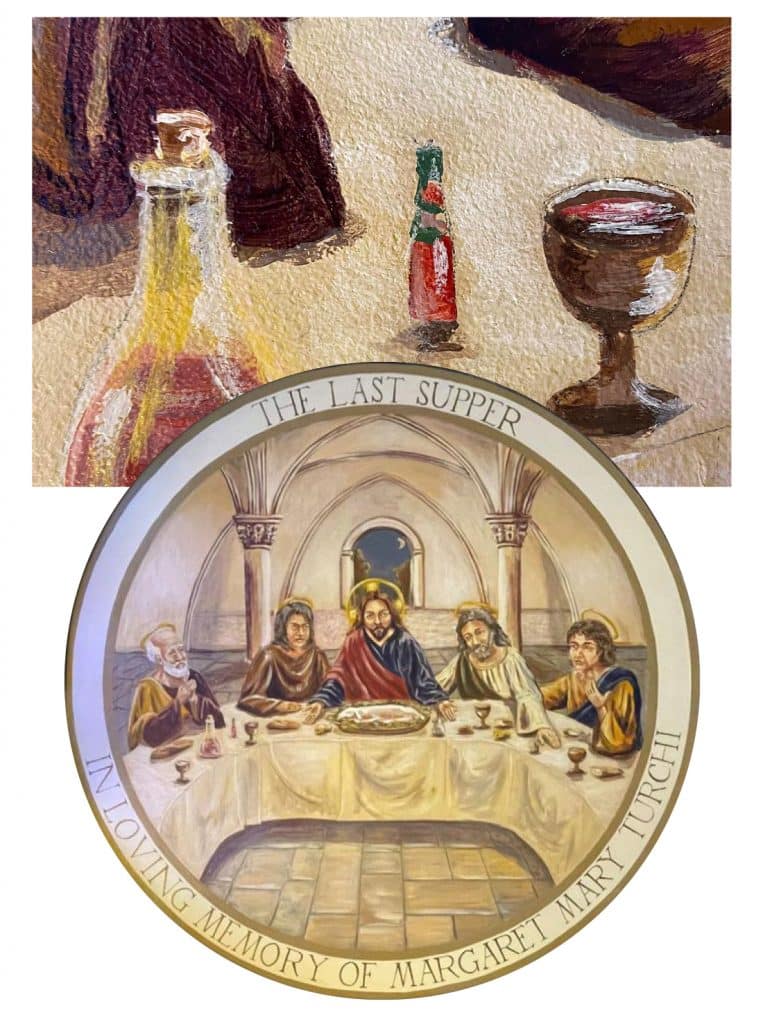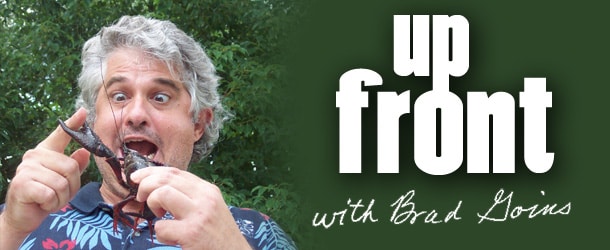When Americans think about the Last Supper — Jesus’ final meal with his disciples — they almost certainly think of the famous painting of the event by Leonardo da Vinci. Among the many artworks inside the St. Joseph Catholic Church in the tiny town of Parks, La., there’s a painting that bears some resemblance to the one by da Vinci. But there are some differences. In the St. Joseph painting, there are four disciples rather than 12. And the St. Joseph painting is circular: not rectangular, as da Vinci’s famous work is.

For a number of years, churchgoers have talked about whether the little bottle of hot sauce could actually be found somewhere in a painting in the church or whether the whole thing was just another urban myth.
The church’s priest, Fr. Nicholas DuPré, said he heard rumors about the Tabasco bottle from the previous priest when he arrived at St. Joseph in 2019.
He said that on at least one occasion, his predecessor asked him, “’Did you find that Tabasco bottle?’ And I was like, ‘What?’ … I never really cared to go look for it.”
But then one day, DuPré got a letter from Shane Bernard of the McIlhenny Co., which makes the famous hot sauce on Avery Island in Iberia Parish. Bernard wanted to know whether there was any truth behind the urban myth that a bottle of Tabasco sauce was indeed part of a painting in St. Joseph’s.
After his inspection, DuPré wrote on Facebook, “It is no myth.” He posted a picture of Bernard’s letter and a closeup of the painting.
Two days later, a large commemorative collector’s bottle of Tabasco sauce arrived at Father DuPré’s doorstep.
“I highly advise looking for hidden bottles of Tabasco sauce in whatever art is hanging in your church,” DuPré wrote on Facebook. “The McIlhenny Co. was kind enough to give me this bottle just for having a little fun.”
DuPré and the congregation haven’t yet decided what will be done with the commemorative bottle, but the father is considering putting it in a vestibule along with some directions about where to find the bottle in the painting with the Tabasco.
The St. Joseph’s painting was commissioned in 2003 by Fr. Bryce Sibley. Christie Hebert, the artist, was asked not to do an exact replica of the da Vinci painting. “He wanted me to make it unique to our area,” Hebert told the Lafayette Daily Advertiser.
Sibley, who left St. Joseph in 2008 to go teach at Notre Dame Seminary in New Orleans, said that when he arrived in 2003, the church needed new paint and artwork and other renovations.
Sibley explained, “I’ve always liked the little human element from different works that I had seen. So I said, ‘Well, why don’t we insert the bottle?’ I’ve been sort of touched by the way that people find the human element of the story so compelling.”
If you want to see the painting for yourself, Parks is not far from here. It sits seven miles south of Breaux Bridge.
Kelley’s Ulysses Paintings
It’s been a while since the Up Fronter checked in on the progress of local artist Heather Kelley. As a rule, Kelley makes art about James Joyce’s novel Finnegans Wake. But recently, the Rosenbach Gallery in Philadelphia has been exhibiting Kelley’s new work about Ulysses, Joyce’s other long novel. The exhibit, “18 Reasons To Read Ulysses,” commemorates the 100th anniversary of the publication of the book.
These new paintings are quite a bit different from the sort of art we’re accustomed to seeing from Kelley. Almost all the paintings are realistic, ranging from wild expressionism (a painting of Leopold Bloom’s breakfast treat of kidneys being cooked in a pot of bright red boiling water with huge flames of bright blue and yellow roaring up the sides) to almost photography reproduction (such as a painting of a simple inkwell).
One painting conveys Joyce’s almost unlimited capacity for sending up the prose of modern advertising and journalism. In this painting, Kelley includes an ad quoted in the novel: “What is home without Plumtree’s Potted Meat? Incomplete. With it, an abode of bliss.” The notion that a home could be made blissful by potted meat indicates that Dublin was even more poor 100 years ago than it is today.
The novel’s protagonist, Leopold Bloom, spends his day in Dublin’s business district but does surprisingly little work. He does manage to pop into a few pubs and drink and chat with friends. In Barney Kiernan’s pub, Bloom encounters a character called simply “the Citizen” — a staunch nationalist who takes Bloom to task for being a Jew. Bloom angrily and effectively defends himself. As he hightails it out of the bar, the Citizen throws an empty tin of biscuits (British for cookies) at Bloom but is too drunk to make a connection. Kelley memorializes this scene with a realistic painting titled Biscuit Box.
Kelley devotes quite a bit of her art to parts of the book that center around Bloom’s wife Molly. For example, Molly’s adulterous meeting with the gigolo Blazes Boylan is depicted in the painting “Blazes and Molly.” The painting, which is made entirely in black and white, resembles a shot in a film noir in which only the main features of each lover’s face are struck by the light.
You can see reproductions of all of Kelley’s paintings at rosenbach.org. Learn more about her work in general at heatherryankelley.com.
Women Musicians Of Acadiana
“Femme II — Celebrating Women in Acadiana Music” will take place Thursday, June 23, 7:30 pm at the Acadiana Center for the Arts at 101 West Vermilion St. in downtown Lafayette. Led by vocalist Anna Laura Edmiston and director and collaborator Lian Cheramie, the performance is a follow-up to the Femme event that took place in 2018 as part of the Louisiana Crossroads series.
Femme II will feature a brand new group of women involved in the arts in South Louisiana, including Sweet Cecilia, Erica Fox, Sheryl Cormier, Gina Forsyth, Michelle Colón, Marguerite Justus and Viola Fontenot. Many of the participants will show or perform work that represents earth, wind, water and fire.
Femme II will include musical, dance and spoken word performances along with archival audio and visual footage provided by the Center for Louisiana Studies at the University of Louisiana at Lafayette.
A prominent feature will be a projected backdrop of work by local artist Erin Broussard. Tickets start at $35. To book tickets, go to acadianacenterforthearts.org, pull down the menu for Shows and Events, then click Louisiana Crossroad series.
Reeser Poems Appear In 64 Mag
You may have seen the magazine 64 Parishes, which is published under the auspices of the Louisiana Endowment for the Humanities. It covers the arts, cooking, and other aspects of Louisiana culture.
A new feature in the magazine includes works by Lake Charles poet Jennifer Reeser. They were chosen by the state’s poet laureate, Mona Lisa Saloy. The link for the poems is 64parishes.org/poems-by-jennifer-reeser.
The first poem included, “Mound of the Unknown Native,” is prefaced by information from LSU about the old Native American mounds near Poverty Point. University scholars say that 6,000 years ago, people in the area lived in separate groups of 50 to 200. At times they met at the sites of the mounds to “exchange information, catch up with friends, trade, perform rituals necessary to the maintenance of the group, and maybe, most importantly, choose a mate from outside [of their group].”
Here is a selection from one of the poems in the group; a work titled “Mound F (Poverty Point, Louisiana)”:
Here decades of decaying leaves
cross a gully deep in woods.
The haunted feel of ghostly sheaves
on fallen wooden limbs intrudes,
as though you’re stepping back,
unknowing, through a crack
in Time’s wild doorway, stripped of worldly goods.
64 Parishes states that Reeser has mixed European-American and Native American Indian ancestry through both her mother and father. Her poems have appeared in such formidable periodicals as Poetry and the Hudson Review. She now divides her time between Southwest Louisiana and Indian Country, Okla. Learn more at jenniferreeser.com.
















Comments are closed.